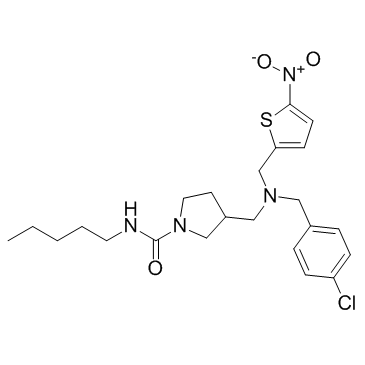| Cas No.: | 1379686-29-9 |
| Chemical Name: | sr-9011,sr 9011,sr9011 |
| Synonyms: | sr-9011,sr 9011,sr9011 |
| SMILES: | O=C(N1CC(CN(CC2=CC=C(Cl)C=C2)CC3=CC=C([N+]([O-])=O)S3)CC1)NCCCCC |
| Formula: | C23H31ClN4O3S |
| M.Wt: | 479.04 |
| Sotrage: | 2 years -20°C Powder, 2 weeks 4°C in DMSO, 6 months -80°C in DMSO |
| Description: | SR9011 is a REV-ERBα/β agonist with IC50s of 790 nM and 560 nM for REV-ERBα and REV-ERBβ, respectively. |
| In Vivo: | SR9011 displays reasonable plasma exposure, thus, the expression of REV-ERB responsive genes is examined in the liver of mice treated with various doses of SR9011 for 6-days. The plasminogen activator inhibitor type 1 gene (Serpine1) is a REV-ERB target gene and displays dose-dependent suppression of expression in response to SR9011. The cholesterol 7α-hydroxylase (Cyp7a1) and sterol response element binding protein (Srepf1) genes have also been shown to be responsive to REV-ERB and are dose-dependently suppressed with increasing amounts of SR9011. After 12 days in D:D conditions mice are injected with a single dose of SR9011 or vehicle at CT6 (peak expression of Rev-erbα). Vehicle injection causes no disruption in circadian locomotor activity. However, administration of a single dose of SR9011 results in loss of locomotor activity during the subject dark phase. Normal activity returns the next circadian cycle, consistent with clearance of the drugs in less than 24h. The SR9011-dependent decrease in wheel running behavior in the mice under constant darkness conditions is dose-dependent and that the potency (ED50=56 mg/kg) is similar to the potency of SR9011-mediated suppression of a REV-ERB responsive gene, Srebf1 , in vivo (ED50=67mg/kg)[1]. |
| In Vitro: | SR9011 dose-dependently increases the REV-ERB-dependent repressor activity assessed in HEK293 cells expressing a chimeric Gal4 DNA Binding Domain (DBD) - REV-ERB ligand binding domain (LBD) α or β and a Gal4-responsive luciferase reporter (REV-ERBα IC50=790 nM, REV-ERBβ IC50=560 nM). SR9011 potently and efficaciously suppresses transcription in a cotransfection assay using full-length REV-ERBα along with a luciferase reporter driven by the Bmal1 promoter (SR9011 IC50=620 nM). SR9011 suppresses the expression ofBMAL1 mRNA in HepG2 cells in a REV-ERBα/β-dependent manner[1] SR9011 suppresses proliferation of the breast cancer cell lines regardless of their ER or HER2 status. SR9011 appears to pause the cell cycle of the breast cancer cells prior to M phase. Cyclin A (CCNA2) is identified as a direct target gene of REV-ERB suggesting that suppression of expression of this cyclin by SR9011 may mediate the cell cycle arrest. Treatment with SR9011 results in an increase in cells in the G0/G1 phase and a decrease of cells in S and G2/M phase suggesting that activation of REV-ERB may be resulting in decreased transition from G1 to S phase and/or from S to G2/M phase[2]. |

 DC Chemicals' products qualify for U.S. tariff exemptions. We guarantee no price increases due to customs duties and maintain stable supply, continuing to deliver reliable research solutions to our American clients.
DC Chemicals' products qualify for U.S. tariff exemptions. We guarantee no price increases due to customs duties and maintain stable supply, continuing to deliver reliable research solutions to our American clients.





















